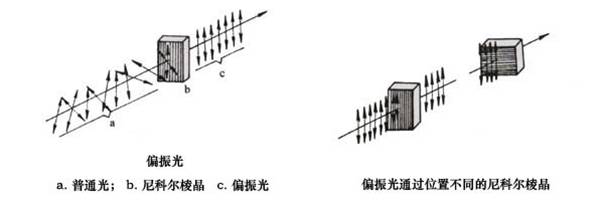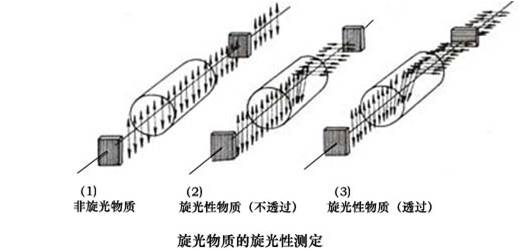Light is an electromagnetic wave whose direction of vibration is perpendicular to the direction of advancement of light. The light waves of ordinary light vibrate in different directions. But if you let it pass a Nicol prism (a prism made of ice stone), the light that passes through the prism vibrates in only one direction (polarized plane). This kind of light is called plane polarized light. . The polarized light passes completely through the Nicol prism, whose crystal axis is parallel to its plane of polarization, and cannot pass through a Nicol prism whose crystal axis is perpendicular to its plane of polarization. When plane polarized light passes through a medium, some medium has no effect on the polarized light, that is, the plane of polarization of the polarized light transmitted through the medium remains unchanged. Some media can rotate the plane of polarization of polarized light. The property of this plane of polarization that can rotate polarized light is called optical rotation. An optically active substance is called an optically active substance or a photoactive substance. Chiral compounds having an asymmetric structure are optically active. A substance that causes the polarization of polarized light to face right-handed is called a right-handed substance; otherwise, it is called a left-handed substance. Usually "d" (abbreviation for Latin dextro, "right") or "+" for right-handed; "l" (abbreviation for Latin laevo, "left") or "-" for left-handed. The angle at which the plane of polarization of the polarized light is rotated by the optically active substance is called the optical rotation and is represented by "α".    The degree of optical rotation depends not only on the nature of the substance, but also on the concentration of the solution, the thickness of the liquid layer, the wavelength of the light, the temperature of the measurement, and the nature of the solvent. Optical rotation of sugar Whether an organic substance such as a monosaccharide is optically active is related to its molecular structure. If the internal structure of the molecule is symmetrical (such as having a plane of symmetry, a center of symmetry, a axis of symmetry, etc.), there is no optical rotation; otherwise, there is optical rotation. The organic molecules present in the organism are mainly composed of four elements: C, H, O, and N, of which only C atoms may form asymmetry. The reason is that C atoms behave as tetravalent, which can be covalently linked to four atoms or groups of atoms. If the four atoms or groups of atoms that are connected are symmetrically arranged, the molecule will behave symmetrically; otherwise, it will behave as asymmetry. This C atom is called an asymmetric carbon atom, or called an asymmetric center, a chiral carbon atom, or a chiral center. Most monosaccharides have at least one asymmetric center (except dihydroxyacetone). Determination of sugar concentration by optical rotation of sugar The optical rotation of an optically active substance is proportional to the product of the concentration of the optically active substance and the length of the polarized light passing through the path of the liquid to be tested. Therefore, in the optical rotation detector, the concentration of a certain substance solution can be measured according to the magnitude of the optical rotation. 1. Turn the sample tube nut away, wash the glass tube, then fill the tube with distilled water, cover the slide, note that there should be no air bubbles in the tube, and the water stain on the slide must be dried. Sugar rotation The optical rotation of the newly prepared 10% glucose solution was measured by the above method and the specific optical rotation was calculated. Then, the optical rotation was measured every 2 hours, and the specific optical rotation was calculated until the specific optical rotation did not change, indicating that the α-, β-type mutual Change has reached equilibrium. SICHUAN UNIWELL BIOTECHNOLOGY CO.,LTD. , https://www.uniwellbio.com

The optical rotation measured by a solution having a thickness of 1 dm and a concentration of 1 g/ml of the substance to be tested is called a specific optical rotation [α], which is a characteristic constant of the substance, as shown in the following formula:
[α]λt=α/cl
Where t: the temperature at the time of measurement;
λ: the wavelength of the light source used in the measurement;
α: measured optical rotation;
c: concentration of the solution (g/ml);
l: the length of the glass tube (dm).
The phenomenon that a specific optical rotation changes after an optically active solution is placed is called a rotation. The reason for the vortex is that the sugar changes from α-form to β-form or from β-form to α-form. All monosaccharides have a spinning phenomenon. No α-, β-type saccharides have no rotatory properties.
The monosaccharide has an asymmetric carbon number, the aldose is n-2, and the ketose is n-3. The number of stereoisomers of the monosaccharide is equal to 2k, where k represents the number of asymmetric carbon atoms.
Dihydroxyacetone, ethanol, glycine and the like have no optical activity.
2. Put the sample into the polarimeter, turn on the power, wait for the sodium source to stabilize for 1-2min, turn the dial, make the brightness of the two halves in the eyepiece equal, and record the reading of the dial, which is zero.
3. The optical rotation was measured by replacing the distilled water with sucrose, and the concentration of sucrose was calculated according to the formula.